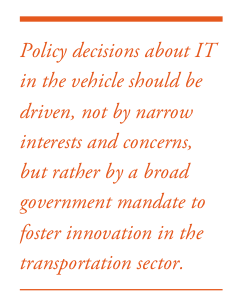THE INFORMATION TECHNOLOGY & INNOVATION FOUNDATION
 Many industries, from health care to entertainment to retail, have undergone dramatic transformations as firms in these industries use information technology (IT) to automate processes, create more efficient supply chains, and collaborate more efficiently. These technology-driven changes have also created new policy issues and revived old policy debates. For example, widespread use of the Internet and mobile devices by consumers has led to dramatic changes in the distribution and pricing models for movies and music, and introduced new policy challenges such as digital piracy.
Many industries, from health care to entertainment to retail, have undergone dramatic transformations as firms in these industries use information technology (IT) to automate processes, create more efficient supply chains, and collaborate more efficiently. These technology-driven changes have also created new policy issues and revived old policy debates. For example, widespread use of the Internet and mobile devices by consumers has led to dramatic changes in the distribution and pricing models for movies and music, and introduced new policy challenges such as digital piracy.
While not all industries have undergone the same degree of transformation, as the use of IT continues to grow, it is impacting these lagging industries. The transportation industry, and in particular the automotive industry, are only now beginning to experience some of the more radical changes that IT and the Internet have brought to other industries. These changes are opening up new possibilities for how individuals use transportation, improving the quality and safety of transportation, and creating profound shifts in our society that may ultimately impact how and where individuals work and live.
And just as IT-driven transformations in other industries have created new policy issues, the same will be true in transportation. The automotive industry will likely face some of the same policy debates and challenges previously seen in other industries further along in the technology adoption lifecycle. Chief among these policy debates will likely be concerns about public safety, data privacy and ownership, free speech and decency, liability, and access to wireless spectrum. While this report will not offer answers to all of the questions it raises, it will argue that the policy decisions about IT in the vehicle should be driven, not by narrow interests and concerns, but rather by a broad government mandate to foster innovation in the transportation sector. This will require leadership from both the government and the private sector and cooperation between different stakeholders.
THE EMERGENCE OF IT-ENABLED VEHICLES
As a result of a variety of factors, including low-cost, energy-efficient processors, cheap sensors, and ubiquitous connectivity, IT increasingly has been integrated or “embedded” into previously non-digital products, such as smart meters and smart phones. The same trend is seen in the automotive industry. In 2011, Akio Toyoda, the president of Toyota, unveiled a concept car he described as a “smartphone on wheels.” This metaphor is an apt description of the technology changes that are occurring within the automotive industry, where on-board computers and network connectivity increasingly are being integrated into vehicles to create “connected vehicles” that can serve as platforms for new innovation and development.
There are at least four important technology trends shaping the next-generation of vehicles:
1) an increase in machine-to-machine communications,
2) the development of in-vehicle “infotainment” systems,
3) the increased collection and use of vehicle data, especially geo- location data, and
4) vehicular automation.
The first trend is the growth of machine-to-machine communications. Machine-to- machine communications is a principle part of the “Internet of Things”, a vision of a world where all devices are networked together to operate more intelligently. The prevalence of machine-to-machine connections is expected to grow from 5 percent of all mobile connections in 2012 to 17 percent of all mobile connections in 2017. Much of this growth in machine-to-machine communications is expected to be driven by the automotive industry with only the healthcare sector expecting to see higher growth.
Currently, one-third of all machine-to-machine communications occurs in the automotive industry. Future growth in machine-to-machine communications will likely be driven by new transportation applications and the increased use of vehicle-to-vehicle and vehicle-to- infrastructure communications. Vehicle-to-vehicle communications involves creating ad- hoc mobile networks to allow communication among vehicles. For example, vehicles may pass along warnings about road conditions or traffic. Vehicle-to-infrastructure communications involves communications between vehicles and the roadway. For example, a vehicle involved in an accident might send an alert to nearby roadway signs, or a roadside unit on a curving highway might communicate to approaching vehicles that there is stopped traffic ahead.
The second trend is the increased amount of IT found in the dashboard of vehicles, particularly “infotainment” systems that provide consumers access to both information and entertainment content. Automobile manufacturers increasingly include IT systems in vehicles that are capable of providing access to multiple functions, including mobile communications, entertainment (e.g., movies and music), GPS-based navigation, vehicle safety information, traffic information, and other information (e.g., points of interest, gas stations, etc.). These infotainment systems may also serve as a platform for other applications provided by non-OEM developers.
Read full report (PDF) here: The Road Ahead
About The Information Technology and Innovation Foundation (ITIF)
www.itif.org
“The Information Technology and Innovation Foundation (ITIF) is a Washington, D.C.-based think tank at the cutting edge of designing innovation strategies and technology policies to create economic opportunities and improve quality of life in the United States and around the world. Founded in 2006, ITIF is a 501(c) 3 nonprofit, non-partisan organization that documents the beneficial role technology plays in our lives and provides pragmatic ideas for improving technology-driven productivity, boosting competitiveness, and meeting today’s global challenges through innovation.”
Tags: digital economy, IT, ITIF, smart cars, The Information Technology and Innovation Foundation, The Road Ahead: The Emerging Policy Debates for IT in Vehicles






 RSS Feed
RSS Feed